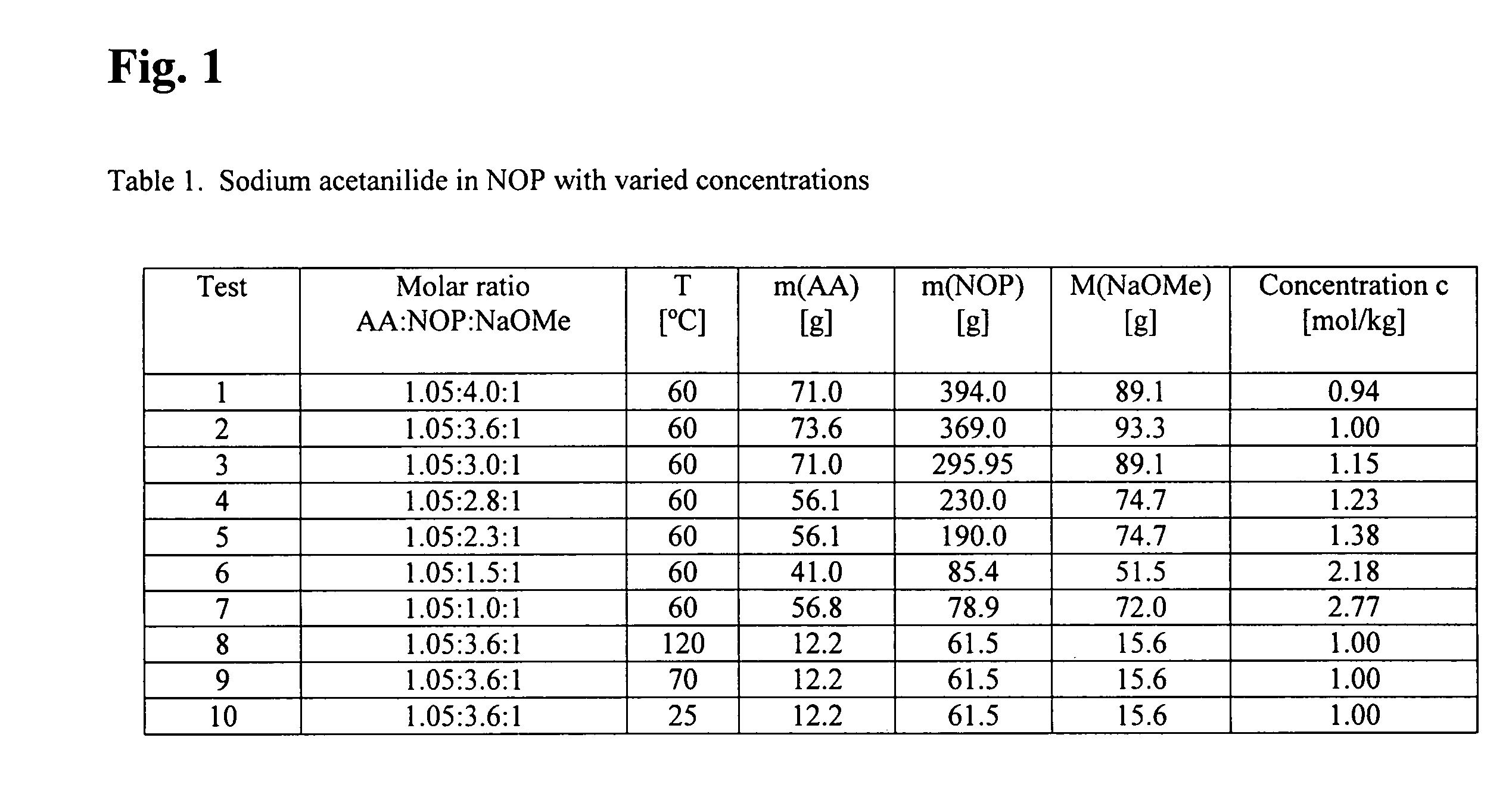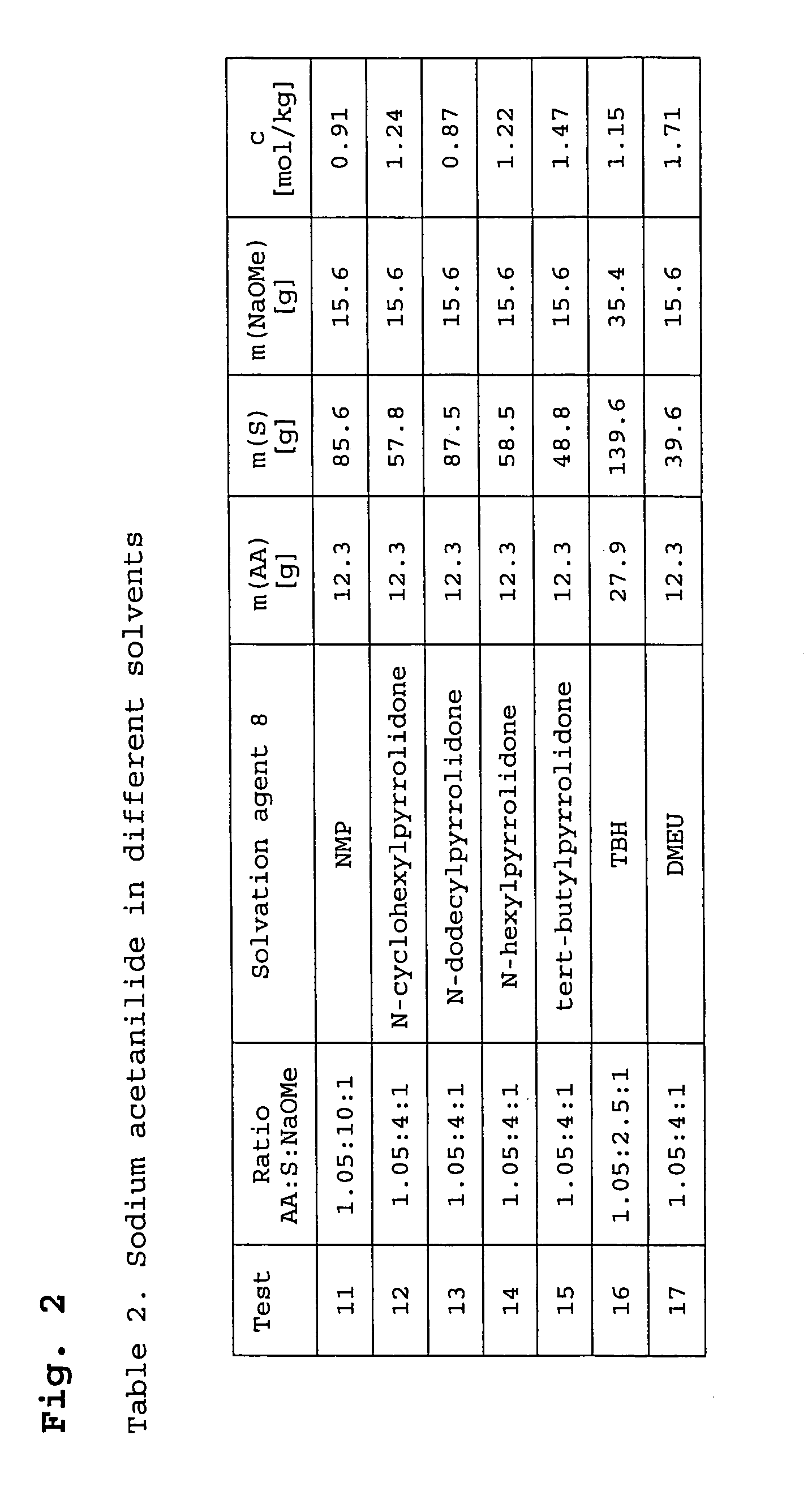Catalyst solution for implementing anionic lactam polymerization, method for production thereof and polyamide moulding compound
a technology of anionic lactam and catalyst solution, which is applied in the direction of organic compound/hydride/coordination complex catalyst, physical/chemical process catalyst, organic compound/chemical catalyst, etc., can solve the problems of discolouration of the produced polyamide, limited storage life of the system of this type,
- Summary
- Abstract
- Description
- Claims
- Application Information
AI Technical Summary
Benefits of technology
Problems solved by technology
Method used
Image
Examples
examples 1 – 10
Examples 1–10
Synthesis of Sodium Acetanilide, NaAA
[0064]The examples 1–10 in Table 1 (FIG. 1) describe the production of the liquid catalyst NaAA directly in the solvation agent NOP.
[0065]In all these examples, acetanilide AA was dissolved in the solvent NOP and quantitatively deprotonated by means of sodium methylate, NaOMe. The ratio AA:NaOMe was chosen to be 1.05:1, AA being used in a slight excess. The ratio AA / S was chosen in a range of 1:4.0 down to 1:1.0, the viscosity noticeably increasing with a lower solvent content. The concentration c increased correspondingly from 0.94 to 2.77 mol / kg. According to the application, the viscosity of the catalyst can be controlled in this way.
[0066]The tests for the synthesis of NaAA are compiled in Table 1. Before syntheses, the reactor system and the educts were carefully freed of water and traces of oxygen. Under inert gas, the acetanilide was firstly dissolved in the solvent NOP with agitation at a temperature of 60° C. Subsequently, s...
examples 11 – 17
Examples 11–17
Sodium Acetanilide in Different Solvents
[0069]The examples 11–17 in Table 2 (FIG. 2) describe the synthesis of NaAA in different solvation agents, and in fact in the pyrrolidones NMP, n-cyclohexylpyrrolidone, n-dodecylpyrrolidone, n-hexylpyrrolidone and tert-butylpyrrolidone and in the ureas DMEU and TBH. The syntheses procedure was analogously to example 1. AA was dissolved in the relevant solvation agent and the sodium-methylate solution added dropwise under vacuum, whereby methanol distilled off. The AA was again used in a slight excess. The catalysts were all obtained as a clear, colourless to brown solution.
examples 18 – 24
Examples 18–24
Polymerisation of NaAA with Different Activators
[0070]The examples 18–21 are cited in Table 3a (FIG. 3) and describe the polymerisation of lactam-12 with NaAA in NOP activated with different activators, the ratio catalyst / activator always being 1:1. All polymerisations were implemented under the same conditions.
[0071]More or less discolouration from colourless to brown occurred with all catalyst-activator mixtures, said discolouration being very noticeably and rapidly in the case of S7000. It was shown that polymers with an optimal colour could be obtained if the relevant mixture was produced just shortly prior to the polymerisation.
[0072]Tests of the stability on storing NaAA in NOP in comparison to the system activated with CyI showed a significantly better stability. After 2 months, the Tu time had not changed, both during storage under inert gas in darkness and on normal oxygen contact and light. The colour index according to Gardner remained constant at 5.4.
[0073]...
PUM
| Property | Measurement | Unit |
|---|---|---|
| Temperature | aaaaa | aaaaa |
| Temperature | aaaaa | aaaaa |
| Fraction | aaaaa | aaaaa |
Abstract
Description
Claims
Application Information
 Login to View More
Login to View More - R&D
- Intellectual Property
- Life Sciences
- Materials
- Tech Scout
- Unparalleled Data Quality
- Higher Quality Content
- 60% Fewer Hallucinations
Browse by: Latest US Patents, China's latest patents, Technical Efficacy Thesaurus, Application Domain, Technology Topic, Popular Technical Reports.
© 2025 PatSnap. All rights reserved.Legal|Privacy policy|Modern Slavery Act Transparency Statement|Sitemap|About US| Contact US: help@patsnap.com



